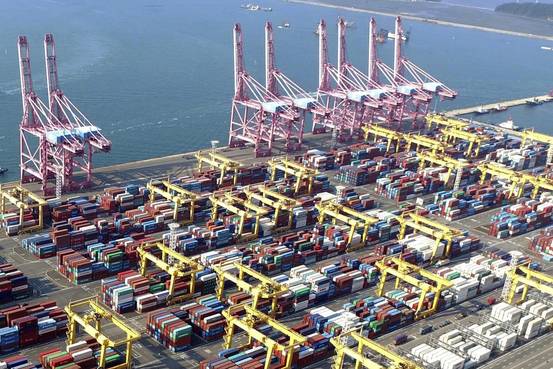U.S. retailers, bracing for a new blow right in the middle of the critical holiday-stocking season, asked the government to step in and help resolve a growing crisis caused by the near-collapse of South Korea’s Hanjin Shipping Co., one of the world’s largest container shipping companies.
“While the situation is still developing, the prospect of harm is significant and apparent,” Sandra Kennedy, president of the Retail Industry Leaders Association, wrote in a letter to the Department of Commerce and the Federal Maritime Commission. Hanjin’s recent bankruptcy filing “presents an enormous challenge to U.S. shippers,” she said, and “could have a substantial impact on consumers and the economy at large.”
Hanjin handles about 7.8% of the trans-Pacific trade volume for the U.S. market, her letter said.
Since Hanjin filed for bankruptcy protection in a Seoul court Wednesday, terminal operators, ports, cargo handlers, truckers and others have refused to handle its cargo, not knowing if they’ll get paid. That is causing chaos at U.S. ports and beyond, said shippers, importers and freight forwarders.
U.S.-bound cargo has been delayed at the point of origin; cargo-laden Hanjin ships are unable to get into U.S. ports. Already delivered cargo sits unhandled, clogging ports and occupying containers needed elsewhere.
A number of Hanjin ships have been barred from shipping out cargo from the main port of Busan, South Korea, and vessels have been turned away from ports in the U.S., China, Canada, Spain and elsewhere.
Because Hanjin is part of an alliance of six shipping companies, the problems are even more widespread.
Brokers in Asia said about 540,000 containers are expected to face delays in deliveries. Those delays could range from a few days to more than a month, according to one.
As capacity tightened overnight during such a busy time, shipping rates soared. Cargo owners said rates from Busan, Korea, to Los Angeles had risen by $600 per container by Thursday from $1,700 four days earlier. Brokers said freight rates likely would continue to rise in coming days as cargo owners are trying to get their goods from stranded ships and are willing to pay a premium.
One U.S. importer said he was getting rate quotes of $2,000 a container, compared with $700 before the Hanjin news.
This can only aggravate problems for retailers grappling with the challenges and high costs of e-commerce and at a crucial time. Those most likely to be affected include Wal-Mart Stores Inc., Target Corp., J.C. Penney Co. and clothing retailers.
A Home Depot Inc. spokesman said Hanjin isn’t its only carrier so it doesn’t expect a material impact. The company is working through contingency plans, he said.
A Target spokeswoman said the retailer is watching development closely and assessing the situation.
Marilee McInnis, a spokeswoman for Wal-Mart, said, “Right now, we are waiting to hear the final determination on bankruptcy proceedings and the implications to their current assets before we will be able to assess any impact.”
The $25 billion U.S. toy industry has been sweating the Hanjin news, as it is stocking up for the holiday season, when about half its annual sales are made.
Jeff Bergmann, managing director of the Toy Shippers Association, said his customers are fortunate that only about 20 containers are on Hanjin or affiliated vessels.
They’ve been told their freight will be delivered to the ports, but from there, “nobody knows,” Mr. Bergmann said.
Beyond that, the general concern is how long the turmoil will last. “The ripple effect could be tremendous,” Mr. Bergmann said.
Jessica Dankert, senior director at the Retail Industry Leaders Association, said the congestion is coming during one of the worse possible times for retailers as they stock up before the critical holiday-shopping season. “These concerns would be trouble at any time, but this is a particularly bad time for it to happen.”
She said retailers are considering contingency plans that include using other carriers and working to get their cargo released.
Reclaiming cargo won’t be easy.
Cargo owners may have to wait for months to get their cargo off Hanjin ships, analysts said.
“In 2001, Cho Yang, a much smaller Korean carrier, went bust and it took six months before a mere 200 containers, handled by a single freight forwarder, could be taken off to ports,” said Lars Jensen of Copenhagen-based SeaIntelligence Consulting. “This is at a much bigger scale so I would not be surprised if scores of boxes on stranded Hanjin vessels ever actually make it to their destination.”
Another issue is the crews. Hanjin ships carry crews of 15 to 25 sailors, and with the vessels unable to call at ports, the sailors could be stranded at sea for weeks or longer.
“They have food and water for a couple of weeks,” said Basil Karatzas of New York-based Karatzas Marine Advisors & Co. “Beyond that, things may become very difficult because suppliers will no longer extend credit to Hanjin and everything must be paid in cash.”
Mr. Jensen said Hanjin quickly must file for bankruptcy protection in Europe and the U.S. to keep its ships moving. Hanjin has secured an injunction protecting its ships against seizure by creditors in Korea and is seeking a similar injunction for protection in ports abroad.
“They got the injunction in Korea, but most of their ships are out at sea or at foreign ports. Ship seizures will continue and increase around the world if there is no bankruptcy protection.” Mr. Jensen said. “But sorting out such legal matters at various jurisdictions is complicated, as Hanjin has no control on how fast foreign courts will examine its case.”
Copyright Ships & Ports Ltd. Permission to use quotations from this article is granted subject to appropriate credit given to www.shipsandports.com.ng as the source.

